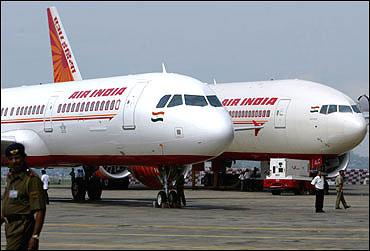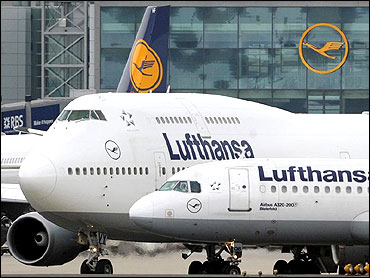Surajeet Das Gupta & Mihir Mishra in New Delhi
Nearly one-third of the 32.07 million international passengers who flew in and out of India in 2009-10 did so thanks to foreign carriers leveraging the sixth freedom rights.
The sixth freedom permits a foreign carrier to fly passengers from one country to another while stopping in its own country.
And, airlines like Emirates, Lufthansa, British Airways, Qatar, Gulf Air and Singapore Airlines - which operate large hubs (like Emirates in Dubai) and offer passengers onward flights to the US and Europe - have used it effectively to increase their Indian market share at the expense of Air India (AI).
The Comptroller & Auditor General of India (CAG) report on AI tabled a few days ago provides data in the public domain for the first time on how the exploitation of sixth freedom rights by foreign carriers was a key cause of AI's troubles.
Click on NEXT for more...
How the govt sounded Air India's death knell
Image: Emirates plane takes off.For instance, the percentage of sixth freedom carriage in 2009-10 in the total passengers carried was as high as 59 per cent for Emirates, 78 per cent for Qatar Airlines, 87 per cent for Lufthansa, 49 per cent for Singapore Airlines and 61 per cent for British Airways, among others (see chart).
Nearly one-fourth of the sixth freedom carriage was done by Emirates alone, which has been one of the chief beneficiaries.
Emirates was able to grab a market share of more than 12 per cent of the Indian international air traffic, more than what the erstwhile Air India was able to garner in 2009-10 (8.6 per cent) or Jet Airways, which had a 10.6 per cent share of the international passengers.
Emirates, Lufthansa, Jazeera, Thai and Singapore Airlines together control more than one-fourth market share of the Indian international air travel business.
Click on NEXT for more...
How the govt sounded Air India's death knell
Image: Etihad.In contrast, the national carrier (which includes the erstwhile AI and Indian Airlines, and Air India Express) together had 21 per cent market share.
The CAG report highlights some key concerns about the government policy on bilaterals. The generous expansion of entitlements beyond the genuine requirement for growth of point-to-point flying (like India-Dubai) did not provide a level playing field for AI.
The CAG report said AI's interests were not protected as it did not get reciprocal entitlement, especially when it asked for it in Dubai.
Experts agree with the CAG view. "Sixth freedom rights given to international carriers like Emirates and Etihad were one-sided.
The same rights were not asked for Air India. So, it was never a level playing field for the national carrier. And, these carriers got the maximum growth from here," said Mohan Ranganathan, a former pilot and member of various government committees.
Click on NEXT for more...
How the govt sounded Air India's death knell
Image: Lufthansa planes.The issue of "excess entitlements" has been highlighted in numerous internal Air India presentations.
Based on 2009-10 data, as much as 99 per cent of the entitlements on the India-Dubai route were used up by the international carrier.
The utilisation by Indian carriers was 55 per cent. On the India-Qatar route, the foreign carrier utilisation was 87 per cent, compared to 20 per cent by Indian carriers.
For Malaysia, the foreign carrier utilisation was 86 per cent, compared to 12 per cent by Indian carriers.
Emirates, Lufthansa, Jazeera, Thai and Singapore Airlines together control one-fourth market share of the Indian international air travel business.
In contrast, the national carrier (which includes the erstwhile AI and Indian Airlines, and Air India Express) together had 21 per cent market share.






article